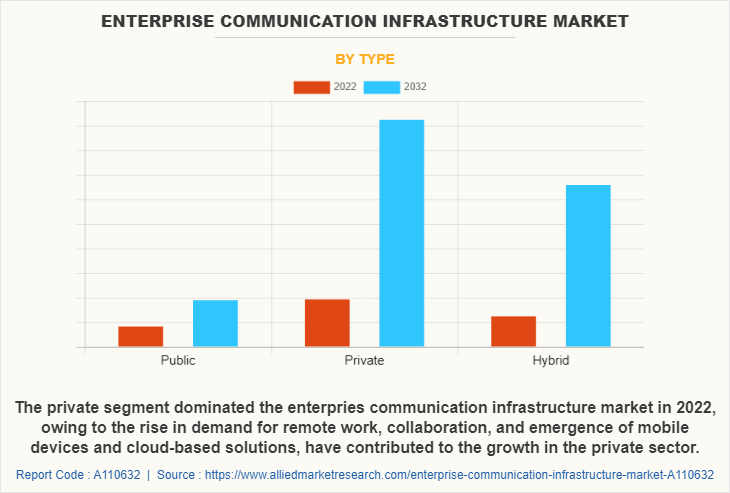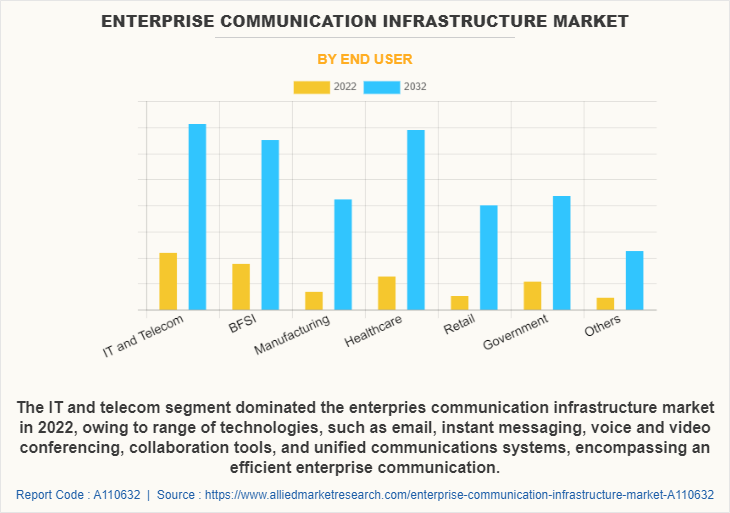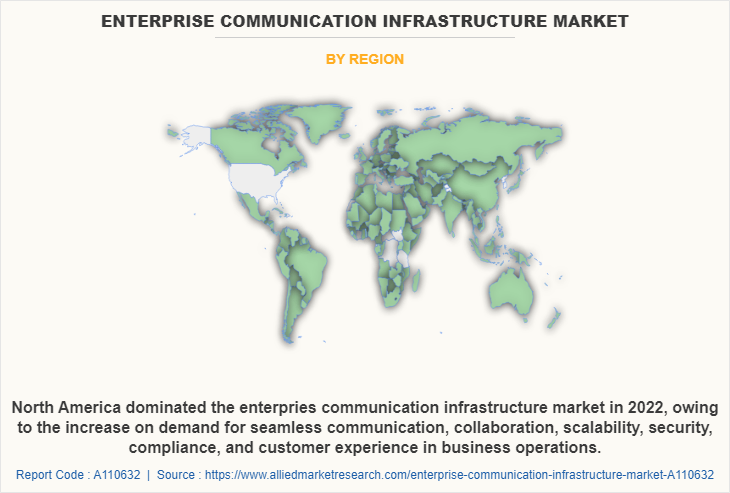Enterprise Communication Infrastructure Market Insights, 2032
The global enterprise communication infrastructure market was valued at $79.5 billion in 2022, and is projected to reach $354.2 billion by 2032, growing at a CAGR of 16.4% from 2023 to 2032.
Factors such as an increase in the need for collaboration and productivity among employees and an increase in demand for enhanced security and compliance primarily drive the growth of the market. However, the cost of implementation and maintenance hamper the market growth. Moreover, an increase in customer engagement and satisfaction is expected to provide lucrative opportunities for global market growth during the forecast period.

Enterprise communications infrastructure is referred to as systems, networks, and technologies that are both physical and virtual. These systems streamline the exchange of information and data between people, businesses, and technology. It serves as the framework for contemporary communication. Nowadays, detailed information can go across local, regional, national, and international networks infrastructure for communications is essential for contemporary society and the global economy. It is essential for many industries, including telecommunications and information technology.
In addition, it is essential for the government, media, entertainment, transportation, and financial sectors. The ability to communicate, collaborate, and exchange information is a major feature of communications infrastructure. The communication infrastructure elements are crucial for contemporary society and the global economy. With the development of technology, the approach of communication keeps evolving. In the digital age, it is essential to determine how people communicate and connect.
The global enterprise communication infrastructure market is segmented on the basis of type, deployment mode, end user, and region. On the basis of type, it is segregated into private, public, and hybrid. On the basis of deployment mode, it is segregated into on-premise and cloud. On the basis of end user, it is divided into IT and telecom, BFSI, Manufacturing, healthcare, retail, government, and others. On the basis of region, it is analyzed across North America, Europe, Asia-Pacific, and LAMEA .
Market players operating in the market include Microsoft Corporation, AT and T Intellectual Property, International Business Machines Corporation, Cisco Systems, Inc., Avaya LLc, Orange Business, ALE International, ALE USA Inc., Verizon, DXC Technology Company, NEC Corporation. Furthermore, it highlights the strategies of the key players to improve the global market share and sustain competition in enterprise communication infrastructure industry.

On the basis of type, private segment dominated the market in 2022, and is expected to maintain its dominance in the upcoming years owing to the rise in demand for remote work and collaboration, emergence of mobile devices and cloud-based solutions, and the need for more integrated and unified communication systems, have contributed to the growth of enterprise communication infrastructure in the private sector. However, hybrid segment is expected segment is expected to witness highest growth, owing to it enhances technologies and tools are expected to be adopted, allowing for greater communication and collaboration capabilities while upholding high standards of security and compliance.

On the basis of end user, IT and telecom segment dominated the market in 2022, and is expected to maintain its dominance in the upcoming years owing enhanced customer service, and streamlined operations. One of the primary applications of enterprise communication infrastructure is to facilitate real-time communication among employees, departments, and branches of an organization However, retail segment is expected segment is expected to witness highest growth during the enterprise communication infrastructure market forecast period, owing to rise of e-commerce and omnichannel retailing has necessitated robust communication systems to seamlessly integrate online and offline operations.

On the basis of region, North America segment dominated the enterprise communication infrastructure market in 2022, and is expected to maintain its dominance in the upcoming years owing to the increase on demand for seamless communication, collaboration, scalability, security, compliance, and customer experience in business operations. However, Asia Pacific segment is expected segment is expected to witness highest growth, owing to the rise in ratio of cloud computing and the growing trend of BYOD in organizations fuels the growth of the market and enterprise Communication infrastructure industry in the Asia-Pacific region.
Top Impacting Factors
Increase in Need of Collaboration and Productivity Among Employees
With the popularity of remote work and distributed teams, it is crucial for businesses to have effective communication solutions that let staff members collaborate effectively from diverse places. The use of numerous communication technologies, including video conferencing, instant messaging, email, and document sharing platforms, is a result of rise in demand for cooperation. With the use of these technologies, workers are able to share information and ideas, interact in real-time, and work on projects together regardless of where they are located.
In addition, the demand for dependable and secure communication infrastructure has expanded owing to the use of mobile devices. Employees expect to be able to access their work-related communication tools from their personal devices due to the growing trend of bring-your-own-device (BYOD) rules, which reinforces the requirement for a reliable communication infrastructure. Furthermore, workplace communication infrastructure is being driven by the desire for more collaboration and productivity as well as the growth of remote work and mobile devices. Organizations must invest in trustworthy and effective communication solutions to enable their staff to collaborate easily and accomplish business objectives. This rise in need for effective communication among employees significantly drives the market growth.
Increase in Demand for Enhanced Security and Compliance
Organizations face rise in number of security dangers and legal constraints as they rely on digital communication technologies to do business. Organizations must take precautions to safeguard their communication infrastructure from sophisticated cybersecurity threats such as data breaches, hacking, and phishing attempts. This entails implementing firewalls, robust authentication procedures, and encryption techniques in addition to continuously checking and updating security systems. Organizations must abide by a number of data protection and privacy laws, including GDPR, HIPAA, and CCPA, in addition to cybersecurity requirements.
Moreover, to preserve confidentiality, integrity, and accessibility of sensitive data, these regulations mandate organizations to use stringent data protection measures, such as secure communication channels and data encryption. Since remote work has become the norm for many organizations, the COVID-19 pandemic has also highlighted the necessity for safe communication infrastructure. Organizations must make sure that their communication tools are safe, and that sensitive data is shielded from unauthorized access when employees work from home. Another major factor for organizational communication infrastructure growth is the requirement for improved security and compliance. Small and medium sized businesses must make sure that their communication platforms are safe and adhere to data protection laws to safeguard sensitive information and preserve the trust of their clients and partners. This has compelled numerous organizations to make investments to secure their communication network and thus, drive the enterprise communication infrastructure market growth.
Regional Insights
By region, the study provides market insights into North America, Europe, Asia-Pacific, and Rest of the World. The anticipated expansion of the market in North America can be attributed to several key factors. The adoption of state-of-the-art technologies, particularly by multinational corporations, is seen as a driving force for market growth. The increasing trend of remote work is fast-tracking the advancement of routers and switches, expected to drive the expansion of business network infrastructure in North America. The demand for wireless access points further underscores the ongoing modernization of internal infrastructure within businesses.
Further, the major countries studied in the market report are the US, Canada, Germany, France, the UK, Italy, Spain, China, Japan, India, Australia, South Korea, and Brazil.
Europe Market accounts for the second-largest market share as European companies are actively embracing digital transformation initiatives to enhance competitiveness and boost operational efficiency. In 2022, a substantial 77.7% of enterprises in the EU facilitated remote access to the email system for their staff. Additionally, nearly two-thirds of enterprises (65.0%) reported that their employees had remote access to essential documents, including files, spreadsheets, presentations, charts, and photos. Moreover, over 60% of enterprises enabled employees to access business applications or software remotely, covering areas such as accounting, sales, orders, and CRM. Large enterprises, in particular, demonstrated a high adoption rate, with 9 out of 10 reporting that their staff had remote access to all three types of ICT systems mentioned. Further, the German market held the largest market share, and the UK Enterprise Communication Infrastructure Market was the fastest-growing market in the European region.
The Asia-Pacific Market is expected to grow at the fastest CAGR from 2023 to 2032. Enterprise collaboration solutions have transformed into fundamental components of business communications and collaboration. The proliferation of the cloud has enhanced the accessibility of office collaboration tools by eliminating the management requirements associated with on-premises equipment. The rise of remote work opportunities has significantly increased the adoption of cloud collaboration. Cloud technology enables employees located in different geographical areas to engage in real-time collaboration seamlessly. According to a 2020 survey conducted by Yotta, approximately 37% of Indian businesses had their digital infrastructure hosted in the cloud. Predictions indicate that by 2022, over 60% of the infrastructure is expected to transition to the cloud, eliminating the necessity for captive availability and third-party co-location. Moreover, China’s Market held the largest market share, and the Indian Market was the fastest-growing market in the Asia-Pacific region.
Key Industry Developments
- In March 2023, Bandwidth Inc., launched Bandwidth Maestro. This next-generation cloud communications platform mainly allows chief information officers to solve the significant challenge of integrating best-in-class real-time voice apps throughout their unified communications, cloud contact center, and artificial intelligence platforms, thereby resulting in faster time-to-value and improved employee and customer experiences. With Bandwidth Maestro, enterprises can easily customize global communications workflows and enhance state-of-the-art CX and AI capabilities like machine-learning-based fraud detection, conversational AI, and text-to-speech and speech-to-text tools, all interoperable and consumable by software.
- In February 2023, a cloud communication company, MyOperator, introduced Heyo Phone, a digital phone line for small and medium businesses. The digital phone connection can help small and medium-sized businesses manage customer interactions and improve their overall customer call and WhatsApp chat experience through a single business number.
- According to Flexera 2023 State of the Cloud Report 2023, around 47% of respondents run significant workloads on Amazon Web Services (AWS). This usage is expected to exponentially enable the market to witness substantial growth opportunities during the forecast period.
Key Benefits for Stakeholders
- This report provides a quantitative analysis of the market segments, current trends, estimations, and dynamics of the market analysis from 2022 to 2032 to identify the prevailing enterprise communication infrastructure market opportunities.
- The market research is offered along with information related to key drivers, restraints, and opportunities.
- Porter's five forces analysis highlights the potency of buyers and suppliers to enable stakeholders make profit-oriented business decisions and strengthen their supplier-buyer network.
- In-depth analysis of the market segmentation assists to determine the prevailing market opportunities.
- Major countries in each region are mapped according to their revenue contribution to the global enterprise communication infrastructure market share.
- Market player positioning facilitates benchmarking and provides a clear understanding of the present position of the market players.
- The report includes the analysis of the regional as well as global enterprise communication infrastructure market trends, key players, market segments, application areas, enterprise communication infrastructure market size and growth strategies.
Enterprise Communication Infrastructure Market Report Highlights
| Aspects | Details |
| Market Size By 2032 | USD 354.2 billion |
| Growth Rate | CAGR of 16.4% |
| Forecast period | 2022 - 2032 |
| Report Pages | 281 |
| By Type |
|
| By Deployment Mode |
|
| By End User |
|
| By Region |
|
| Key Market Players | Cisco Systems, Inc., DXC Technology Company, AT&T Intellectual Property, NEC CORPORATION, Avaya LLC, Microsoft Corporation, International Business Machines Corporation, ALE International, ALE USA Inc., Verizon, Orange Business |
Analyst Review
Since effective cooperation and communication are critical for attaining company goals and increasing growth, the enterprise communication infrastructure market is crucial for the success of firms. Leading market players are interested in cloud-based solutions that offer flexibility and scalability as they continuously look for novel ways to enhance productivity, improve communication, and cut expenses. However, enterprises are aware of the difficulties in integrating communication technologies, such as integration problems and security worries, and technicians constantly try to resolve these problems. Emerging technologies such as AI and IoT that are capable of further improving communication and collaboration within the organization are also of importance to them.
Key providers in the enterprise communication infrastructure market are Cisco Systems, Inc., IBM Corporation, and Orange Business. With the growth in demand for communication services, various companies have established partnerships to increase their solutions offerings in enterprise solutions. For instance, in March 2023, Cisco partnered with NTT, through this alliance the companies have launched private 5G services across automotive, logistics, healthcare, retail, and public sectors. The services are intended to help enterprise customers accelerate digital transformation with the power of 5G and Wi-Fi across IT operations, further, it helps in driving market growth.
In addition, with the surge in demand for communication infrastructure, various companies have expanded their current product portfolio to continue with the rising demand in the market. For instance, in November 2022, Avaya launched Avaya Experience platform, it is an updated and simplified product roadmap. The aim of the platform is to empower organizations to support the touch points that occur between the business or brand and the end customers, but then weaving them into an ongoing discussion. It has improved the way people work and the production efficiency of industries.
For instance, in March 2023, OneWeb partnered with Orange S.A. (Orange). With this partnership, Orange will offer enriched connectivity, integrating OneWeb’s LEO technology, to enterprise customers and telco operators in different regions of the world. This strategic partnership is expected to drive market growth.
Increase in customer engagement and satisfaction are the upcoming trends of Enterprise Communication Infrastructure Market in the world
Increase in need of collaboration and productivity among employees and increase in demand for enhanced security and compliance are the leading application of Enterprise Communication Infrastructure Market
North America is the largest regional market for Enterprise Communication Infrastructure
The global generated $79531.68 million in 2022 and is estimated to reach $354239.56 million by 2032, exhibiting a CAGR of 16.4% from 2023 to 2032 is the estimated industry size of Enterprise Communication Infrastructure
Market players operating in the enterprise communication infrastructure market include Microsoft Corporation, AT and T Intellectual Property, International Business Machines Corporation, Cisco Systems, Inc., Avaya LLC. Orange Business, ALE International, ALE USA Inc., Verizon, DXC Technology Company, NEC Corporation.
Loading Table Of Content...
Loading Research Methodology...



